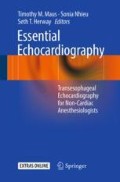Abstract
Echocardiographic evaluation of the aortic valve is not limited to just the valve leaflets itself but also should include the left ventricular outflow tract, sinuses of Valsalva, and the sinotubular junction. Echocardiographic evaluation of any valve pathology should include a thorough two-dimensional examination of the valve and associated anatomic findings, color flow Doppler interrogation, and spectral Doppler analysis. Aortic stenosis is one of the most common cardiac pathologies and can be caused by atherosclerotic thickening over time, congenital bicuspid disease, or rheumatic heart disease. The severity of the stenosis can be assessed by planimetry, spectral Doppler analysis using the continuity equation, mean gradient measurement, and by evaluation of color flow through the valve leaflets. Aortic regurgitation may be caused by root dilatation from vascular or connective tissue disease processes as well as leaflet pathology. Color flow Doppler analysis is a key to determining disease severity through measurement of the vena contracta and jet width to left ventricular outflow diameter. Measurement of the aortic regurgitation pressure half time and determining if there is any reversal of blood flow within the descending aorta will also help to assess disease severity.
Access this chapter
Tax calculation will be finalised at checkout
Purchases are for personal use only
References
Bellhouse BJ, Bellhouse FH. Mechanism of closure of the aortic valve. Nature 1968;217:86–87.
Tribouilloy CM, et al. Circulation. 2000;102:558–64.
Horstkotte D, Loogen F. The natural history of aortic valve stenosis. Eur Heart J 1988;9(Suppl E):57–64.
Nadir MA, Wei L, Elder D, Libianto R, Lim T, et al. Impact of renin-angiotensin system blockade therapy on outcome in aortic stenosis. J Am Coll Cardiol. 2011;58(6):570–6.
Reeves ST, Finley AC, Skubas NJ, Swaminathan M, Whitley WS, Glas KE, et al. Basic perioperative transesophageal echocardiography examination: a consensus statement of the American society of echocardiography and the Society of cardiovascular aneshesiologists. J Am Soc Echocardiogr. 2013;26:443–56.
Baumgartner H, Hung J, Bermejo J, Chambers JB, Evangelista A, Griffin BP, et al. Echocardiographic assessment of valve stenosis: EAE/ASE recommendations for clinical practice. J Am Soc Echocardiogr. 2009;22(1):1–23.
Godley RW, Green D, Dillon JC, Rogers EW, Feigenbaum H, Weyman AE. Reliability of two-dimensional echocardiography in assessing the severity of valvular aortic stenosis. Chest. 1981;79:657–62.
Lindman B, Bonow R, Otto C. Current management of calcific aortic stenosis. Circ Res. 2013;113:223–37.
Bekeredijian R, Grayburn P. Valvular heart disease: aortic regurgitation. Circulation. 2005;112:125–34.
Lancellotti P, Tribouilloy C, et al. European association of echocardiography recommendations for the assessment of valvular regurgitation. Part 1: aortic and pulmonary regurgitation (native valve disease). Eur J Echocardiogr. 2010;11(3):223–244.
Author information
Authors and Affiliations
Corresponding author
Editor information
Editors and Affiliations
Electronic supplementary material
Below is the link to the electronic supplementary material.
Aortic Stenosis: A ME AV SAX view of a severely calcified aortic valve. Notice the clear distinction of the three leaflets ruling out congenital bicuspid disease (AVI 9,309 KB)
Bicuspid aortic stenosis: A mid-esophageal aortic valve short axis view of a congenital bicuspid aortic valve (AVI 3,677 KB)
Flow Acceleration and Turbulence: A ME AV LAX view of flow acceleration in the LVOT as blood flow moves into a stenotic aortic valve orifice. Note the concentric or hemispheric color pattern. High velocity flow distal to the valve causes a turbulent heterogenous color pattern (versus a laminar homogenous color pattern in normal flow) (AVI 10,950 KB)
Malcoaptation: A ME AV LAX view in a patient with bicuspid aortic valve disease and a dilated annulus and aortic root (AVI 3,522 KB)
Aortic Regurgitation: A ME AV LAX view in a patient with an ascending aortic dissection and severe aortic regurgitation (AVI 1,514 KB)
Rights and permissions
Copyright information
© 2016 Springer International Publishing Switzerland
About this chapter
Cite this chapter
Benggon, M., Griffiths, T. (2016). Aortic Valve. In: Maus, T., Nhieu, S., Herway, S. (eds) Essential Echocardiography. Springer, Cham. https://doi.org/10.1007/978-3-319-34124-8_7
Download citation
DOI: https://doi.org/10.1007/978-3-319-34124-8_7
Published:
Publisher Name: Springer, Cham
Print ISBN: 978-3-319-34122-4
Online ISBN: 978-3-319-34124-8
eBook Packages: MedicineMedicine (R0)

